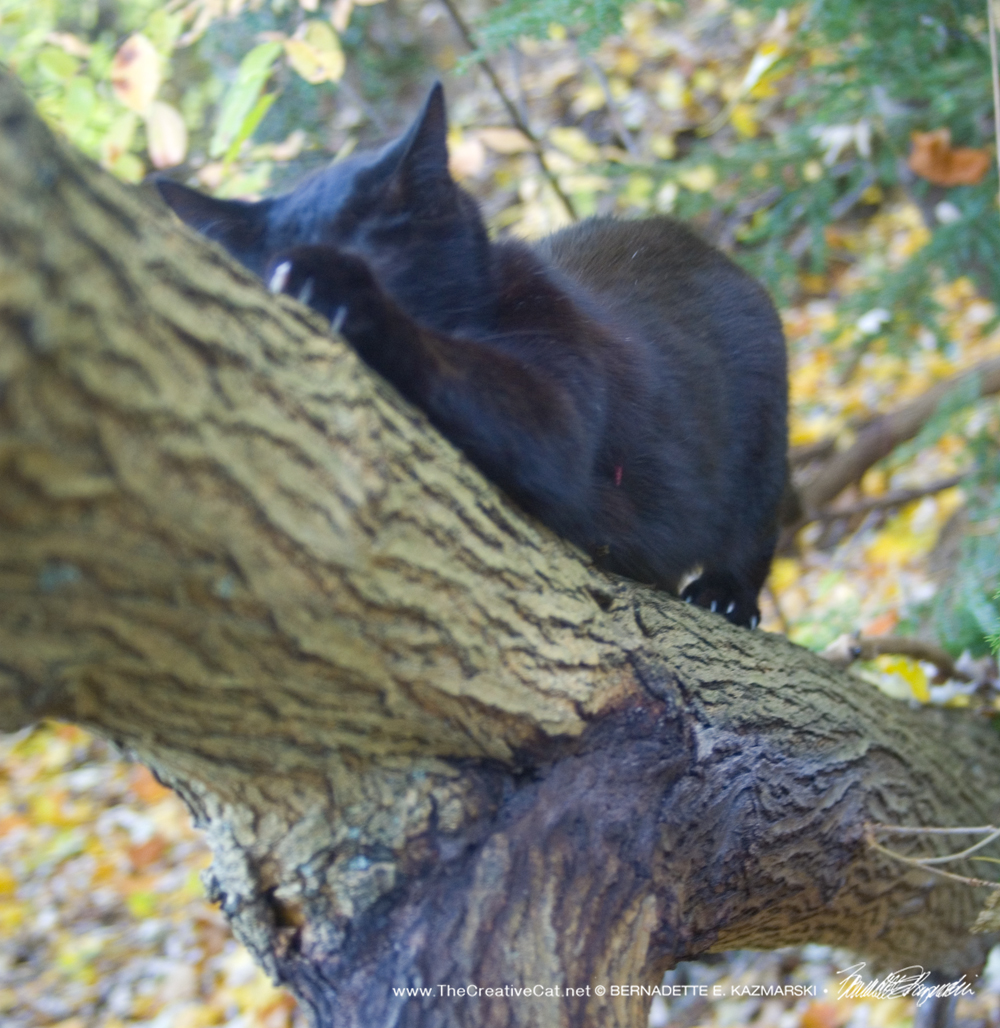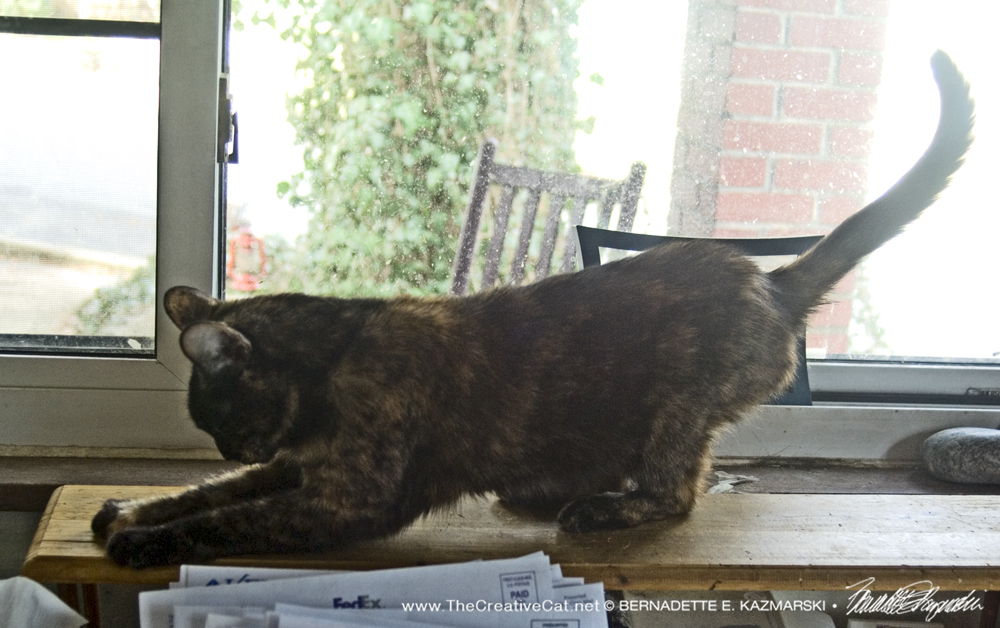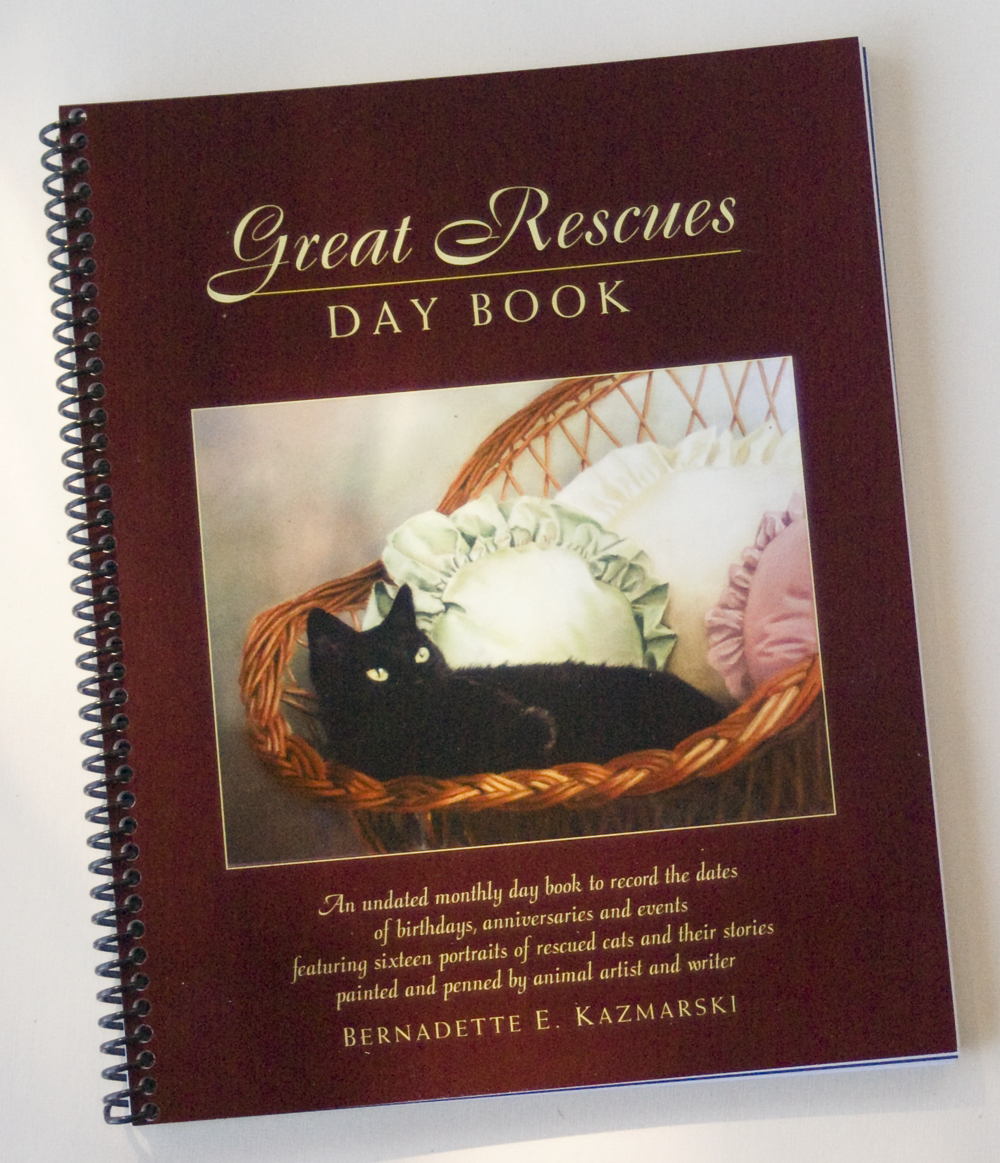Nothing Like a Good Scratch, Though You Might Disagree

There she is again, having an obviously great time ripping more stuffing out of the arm of the chair, right in front where it can’t be hidden or easily fixed. It’s a good thing she’s pretty fast because you’d probably do something you’d regret later if you could get your hands on her.
But before you get into a rundown with your cat, remember that you are only seeing one small part of a whole behavioral ritual that all cats, large and small, indulge in. Seeing the whole pattern is the best way to try to alter the behavior.
When your cat first walked into the room, she momentarily paused at the doorway, swiveled her ears and looked around before actually entering, slightly bobbing her nose. Then she walked in, confident that she had not seen, heard or smelled any potential dangers or unfamiliar creatures.
And here, how convenient to the entry to the room, was the chair. Just to make sure that any body or any thing that entered the room knew exactly what nine-pound panther owned that room as territory, she approached the lower arm of the chair and rubbed both sides of her face on it, nose to ear, then walked along the chair rubbing her side against it, and finally turned around and lustily dug her claws into the fabric and stuffing in the spot that she had already loosened to her liking, and clawed with abandon.
Suddenly you exploded in screaming hysteria and headed toward her as she yanked her claws out of the fabric and leapt away just in time to save her own life. She just doesn’t get it—don’t you understand that she was only trying to let all the travelers along this same communal territory know she was here by leaving her scent and mark on the first thing they’d pass upon entering? Even if they didn’t smell it, as humans never seem to, they’d see those fierce claw marks!
Or consider this scenario. You feed her a nice dinner and both of you head for the living room for a relaxing evening. You plop down on the couch and she sits in the middle of the oriental rug in the middle of the room. She has a nice, thorough bath, cleaning every hair and flexing every muscle, and as a finishing touch, she stands up, rubs her paw pads on the nice, rough wool of the oriental rug, then extends her claws into the wool to clean them and slough off the old claw layers, pulling backward with as much force as she can muster to make sure the job is done well.
Again you leap off the couch as if you’ve been attacked and she runs in fear when she sees you headed for her with arms outstretched like a screeching predator. How is a cat to make sure she’s got nice nails if she can’t clean them up in the only way she knows how?
What to do?
It’s fun to laugh at our own behavior and kitty’s reaction, but cats scratching things they shouldn’t often gets them into trouble and is no laughing matter at all—being destructive is high on the list of reasons cats are abandoned or surrendered to shelters, and it’s the main reason people have cats declawed. That’s a pretty extreme response to a normal cat behavior.
And sometimes it’s our own fault. Cats will scratch, it’s just the way it is, and when we react, even though we think we’re frightening them away from that activity, we are often giving them reinforcement in the form of attention. It can even become like a little game because they can get us to play chase with them!
But once the game is started and you are both fully engaged, how to get them to stop?
Dr. Marci L. Koski, Certified Feline Behavior & Training Consultant, explains, “The best way to handle this is to 1) try to make the inappropriate scratching location unappealing , 2) ignore inappropriate scratching when it happens , and 3) use POSITIVE REINFORCEMENT to encourage scratching in an appropriate location.”
Reasons for scratching
Part of the solution in this case is also to remember why she was scratching in that area in the first place. She scratched that chair because it was along a common pathway, in a highly frequented part of kitty’s territory.
“It’s thought that cats tend to mark objects that are found along common pathways that are traveled within their territory so that scent and visual marks can communicate information to others traveling those same pathways,” Dr. Koski explained. “I know of at least one study that found that cats chose to scratch along common pathways more than around the perimeter of their territory, so from this it appears that scratching is not really intended to map out territories, but communicate within them,” she continued.
It also explains why, when kitty’s scratching post or cardboard scratching pad is put in an out of the way spot, so you don’t trip on it and no one has to see the tangled mess it becomes, that kitty won’t use it, or may use it but will still also use your chair. It’s not communicating anything back in that corner behind the couch because it’s not along a common pathway, though it might still do a fine job of helping her clean her claws and stretch her back.
Putting it into action
The examples above may explain at least two of the motivations cats have for scratching and help you to persuade your cat to start scratching something else in those circumstances. Your job is to analyze the need for scratching in a certain situation, find an acceptable substitute for the item being scratched such as a cat scratching post or pad, and convince your cat to change over to it.
Items for cats to scratch abound in pet stores and can even be made at home. Since cats scratch in different places, ways, and for different reasons, you need to provide more than one scratcher for her to use that matches the different needs for scratching. The two instances mentioned above show that she has already used two different items, one that needs to be shredded to use as both a visual and scent marker and one that needs to be stiff to clean up messy claws.
First, watch what your cat does before and after the scratching behavior. This will help you to establish why she is scratching in that spot and why that item, and to determine a substitute to be used in that place. Place the item right where she’s been scratching to make it clear that you consider this item to be of equal use. In the case of the chair, you would want to find something that is at least as tall as the arm of the chair and have a similar texture.
You also need to somehow cover or mask the area that’s been used, both to get her to stop using that spot and to get her to consider the item you’ve presented. Cats generally choose something with a rough texture to scratch, so if you cover the item with something smooth, like heavy plastic or packing tape, it no longer appeals to them. Products such as Sticky Paws, similar to double-sided tape, work well because cats can’t stand anything sticking to their paws, and if they encounter it often enough they will usually quit visiting the area. After a while you can remove the product.
Next, you get to make a fool of yourself, gritting your teeth and keeping calm when she attempts to shred the chair again, gently redirecting her to the new item, and perhaps even giving it a little scratch yourself, just to make sure she gets the idea. You can make it more enticing by placing a catnip toy on the scratching post or sprinkle catnip all over it to initially attract the cat, drag a string, feather toy or other toy over it to make her pounce and dig her claws into it, or run the dot of a laser toy over it.
“Ignoring inappropriate behavior can be tough, especially if your cat is destroying something,” Dr. Koski said. “If you must, go over to your cat very neutrally, silently remove your cat from the object—don’t say anything or pet her or treat her roughly—and walk away. A moment later, entice your cat over to an appropriate scratching surface with a toy or a treat and dangle it just over the scratcher so that she has to reach up to get the treat/toy,” she continued. “Give her the reward, and lots of affection. After some repetition, your cat will learn that the best way to get your attention will be to use the appropriate scratching surface.”
“Positive reinforcement really is the best way to teach cats to do anything,” Koski explained. “Positive reinforcement can be anything your cat enjoys—affection, sweet-talk, play, and of course, treats.”
You can slowly move the scratching post away from the arm of the chair, but remember to keep it where it serves its other purpose—that of message board to others who pass that way.
In the case of the oriental carpet you don’t need to place a post to redirect kitty’s scratching. Instead, a flat or inclined cardboard scratcher is ideal because it mimics the actions she’s already taking. You can place it over her preferred scratching place, sprinkle some catnip, and let her rip away.
All cats are different, some like to reach up and stretch, others like to stretch out on the floor, some like cardboard, some like wood, some like sisal, some like carpet. Now, you may not want to live with sisal scratching posts at every doorway or sticky tape on the back of your chair. You can gently move or remove these items and your cat will probably go along with it. Just remember that her motivations for her interior living space are actually quite different from yours, and you may need to make some accommodations for her instinctual behavior.
If you’re concerned about décor, quality cat furniture comes in different sizes, designs and post coverings and blends easily with room décor. Posts covered with sisal or made of natural wood are often favorites and almost insure frequent usage.

Scratching around “my” house
There’s a lot of communication happening around here at any given time, and has been for decades. With a multiple cat household usually numbering nine or more and then fosters, especially in a home as small as mine, scratching can also help with stress relief.
I’m not so concerned for my possessions—someday I’ll have “nice stuff”—but I do foster kittens and cats for adoption and I want them to learn appropriate behavior. I have always had scratching items near doorways so that cats can check who’s come into the room and when, and then add their part to it. These include cat trees, posts covered with sisal or simply wood, or more natural ones like a solid section of a tree trunk or branch with bark. The cat tree at the bottom of the stairs takes a beating all day long as cats race down the steps and leap onto it to have a good scratch from the first time we come down the stairs in the morning till we go upstairs at night. The tree at the bottom of the basement steps is also by the door to the outside and sees a lot of communication from activities in the basement including litterbox use and mouse watch. The sections of tree trunks and branches have cats waiting in line for their turn to scratch as we go into the kitchen or up the stairs.
I also have some sort of a scratching device in each room, like round turbo scratchers and flat, inclined or decorative cardboard scratchers. Cats like to stretch and scratch when they wake up, and upstairs is a prime napping area. It’s also where fosters start out so that when the bathroom/foster room door is closed there is a turbo scratcher to burn off the frustration of a door being closed (and the certainty that the cat in there is getting the best of everything all day long). When the bathroom door is open there is another turbo scratcher in there along with one or more other scratchers, and the familiarity of them to both my cats and fosters helps ease tensions and welcome the new kitties as everyone stops to have a scratch and whack the ball around the track, mingling their scents.

Just understand
Your cat is going to scratch things. Understand and anticipate this, don’t punish scratching the wrong thing or react in any way that gives attention, instead reward positive behavior. Find what your cat likes and give it to her and chances are you’ll get along fine.
Resources:
Dr. Marci Koski, certified Feline Behavior and Training Professional, www.felinebehaviorsolutions.com
Articles by Dr. Koski:
Stop Scratching without Declawing, www.felinebehaviorsolutions.com/stop-scratching-without-declawing
How to Use Positive Reinforcement for Good Cat Behavior, www.felinebehaviorsolutions.com/use-positive-reinforcement-good-cat-behavior
Cats surrendered for behavioral reasons:
Common Surrender Reasons (Cats), www.mspca.org/pet_resources/common-surrender-reasons-cats
Study: Behavioral Reasons for Relinquishment of Dogs and Cats to 12 Shelters, https://www.researchgate.net/profile/Philip_Kass/publication/45251733_Behavioral_Reasons_for_Relinquishment_of_Dogs_and_Cats_to_12_Shelters/links/02bfe50eeeb0123565000000.pdf
Read more articles about Health and Safety
Gifts featuring cats you know! Visit Portraits of Animals
Fine Art • Photography • Gifts • Greeting Cards • Books • Commissioned Portraits & Artwork
Great Rescues Day Book:
Portraits, Rescue Stories, Holidays and Events, Essential Feline Information, All in One Book

Each month features one of my commissioned portraits of a feline or felines and their rescue story along with a kitty quote on the left page, and on the right page the month name with enough lines for all possible dates, with standard holidays and animal-themed observances and events. Great Rescues also includes a mini cat-care book illustrated with my drawings including information on finding strays or orphaned kittens, adopting for the first time or caring for a geriatric cat, a list of household toxins and toxic plants, or helping stray and feral cats and beginning with TNR.
Each book includes also 10 sheets of my “22 Cats” decorative notepaper with a collage of all the portraits in black and white so you can make your own notes or write special notes to friends.
The portraits in this book, collected as a series, won both a Certificate of Excellence and a Muse Medallion in the 2011 Cat Writers’ Association Annual Communication Contest, as well as the 22 Cats Notepaper mentioned below.

Copyright
All images and text used on this site are copyrighted to Bernadette E. Kazmarski unless otherwise noted and may not be used without my written permission, although links to your site are more than welcome and are shared. Please ask if you are interested in using and image or story in a print or internet publication. If you are interested in purchasing a print of an image or a product including it, check my animal and nature website Portraits of Animals to see if I have it available already. If you don’t find it there, visit Ordering Custom Artwork for more information on a custom greeting card, print or other item.
Subscribe to my e-newsletter
Subscribe to The Creative Cat Preview E-newsletter.
© 2022 | www.TheCreativeCat.net | Published by Bernadette E. Kazmarski
Weekly schedule of features:
Sunday: Essays, Pet Loss, Poetry, The Artist’s Life
Monday: Adoptable Cats, TNR & Shelters
Tuesday: Rescue Stories
Wednesday: Commissioned Portrait or Featured Artwork
Thursday: New Merchandise
Friday: Book Review, Health and Welfare, Advocacy
Saturday: Your Backyard Wildlife Habitat, Living Green With Pets, Creating With Cats
And sometimes, I just throw my hands in the air and have fun!


